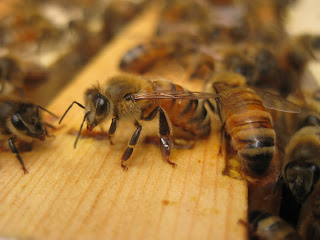It has officially been three weeks since the bees arrived. They have been quietly going about their business, and I have enjoyed many moments sitting and watching them. To stand at a distance and observe them going to and from the hive is pretty neat. I have been trying to catch sight of them in their pursuit of nectar, but once they have launched from the hive their tiny specimens are lost amid the backdrop green. In other words, I have no idea where they are collecting from, and I'm beginning to realize that I may never be able to actually track them down. I guess this will come with more time and observation.
A Look into their Crowded work Life
It's interesting, the bees seemed completely uninterested in the intense amount of sugar and water mixture that I set out for them. In fact, the jar was mostly full up until about six days ago. Then all of a sudden they drained a one quart mason jar in a day. Go figure? What I've decided is that they can be unpredictable. It really shouldn't come as a surprise to me since every bee keeper I've spoken with has differing opinions about what works with the bees. And lots of the information I've read has conveyed the obvious truth that bees cannot be tamed, they are wild in their own rite and they must do whatever their particular hive needs in order to survive.
A first look
The first time opening the hive was intimidating. Being a total novice, I felt like a blank book whose pages needed to be written with the proper instructions on what to do. Jon and I went together, taking turns holding the smoker tool and working with the hive. Our main objective was to check on the outermost frames to see if the bees had begun to build comb on the extremities of their hive body.
Hive body with Frame "2" Removed.
What we discovered in the process was that our bees still had frames 1 and 2 as well as 9 and 10 to begin building their intricate combs upon. As you'll notice, the foundation within the frame did not contain any comb whatsoever. Now, in the event that the bees had begun building comb on frames 2 and 9, our next step would have been to switch 2 and 9 to the outermost spaces (essentially switching them into 1 and 10's spot - sorry, if this sounds confusing). We made a small mistake. Although the bees had not built on any of these four exterior frames, we switched them any way. This wasn't necessary. It's only effective to switch the frames if in fact comb is being built, and since there wasn't the presence of comb yet it wasn't helpful to switch them.
Jon holding an exterior frame devoid of comb
Propolis
Another goal in opening the hive was to remove propolis. Propolis (as seen above) is a resinous substance that is thick and waxy which the bees use to build their comb. Within these waxy hexagonal figures the queen lays eggs to build her brood, and they are also used to store the golden goodness we call honey. As a bee keeper, you want the bees to build within the frames and not along the top of the frames or out of the top of the hive body itself. So, this beautifully built extension of propolis that you see in the photo above had to be gently scraped away.
Building Comb
Opening the hive was awesome! It was unbelievable to encounter all the thousands upon thousands of bees. And to say that I wasn't nervous would be a lie, I was definitely nervous. But I was also mesmerized by the beauty of it all. Thankfully, neither Jon nor I were stung. Actually, the bees didn't even seem to mind our presence much at all. In truth, I can probably attribute their laid back behavior to the endless puffing from the smoker tool! But the most essential tool (if I may call it that) of this experience, this intrusion of their home was gentleness.
















1 comment:
The pictures look scarey with all those bees, but you sound so calm as you talk about your gentle intrusion. Thanks for sharing this adventure with all of us.
Post a Comment